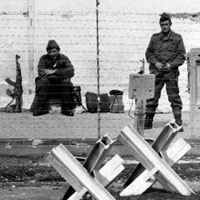Milestones
- 1961-1968: Entangling Alliances
- The Bay of Pigs and the Cuban Missile Crisis, 1961-1962
- Alliance for Progress and Peace Corps, 1961-1969
- The Limited Test Ban Treaty, 1963
- U.S. Involvement in the Vietnam War: the Gulf of Tonkin and Escalation, 1964
- The India-Pakistan War of 1965
- Arab-Israeli War of 1967
- U.S. Involvement in the Vietnam War: The Tet Offensive, 1968
- Soviet Invasion of Czechoslovakia, 1968
- The Nuclear Non-Proliferation Treaty (NPT), 1968
Milestones: 1961-1968
1961-1968: Entangling Alliances
Mounting tension between the United States and the Soviet Union, and war in Vietnam determined U.S. foreign policy in the 1960s. In 1961, the Soviet Union erected the most iconic image of the Cold War, the Berlin Wall, which physically divided the Western and Eastern Blocs of Germany's city of Berlin.

Guards at the Berlin Wall
The following year, the Cuban Missile Crisis brought the United States and the Soviet Union to the brink of armed conflict, as U.S. ships blockaded Cuba preventing Soviet attempts to deliver nuclear warheads to the island. On the other side of the world, burgeoning conflict in Vietnam created a major dilemma for U.S. foreign policymakers. Determined not to lose either the nation of South Vietnam or the broader region of Southeast Asia to communism, U.S. officials committed the United States to military action to stop North Vietnamese nationalist Ho Chi Minh. After President John F. Kennedy's assassination on November 22, 1963, President Lyndon B. Johnson continued to commit significant military expenditures to the conflict in Vietnam, particularly after a 1964 Congressional resolution that gave the President unprecedented power to increase the U.S. presence in Southeast Asia. This costly foreign policy eventually influenced domestic politics as the war in Vietnam grew increasingly unpopular with the American public.
